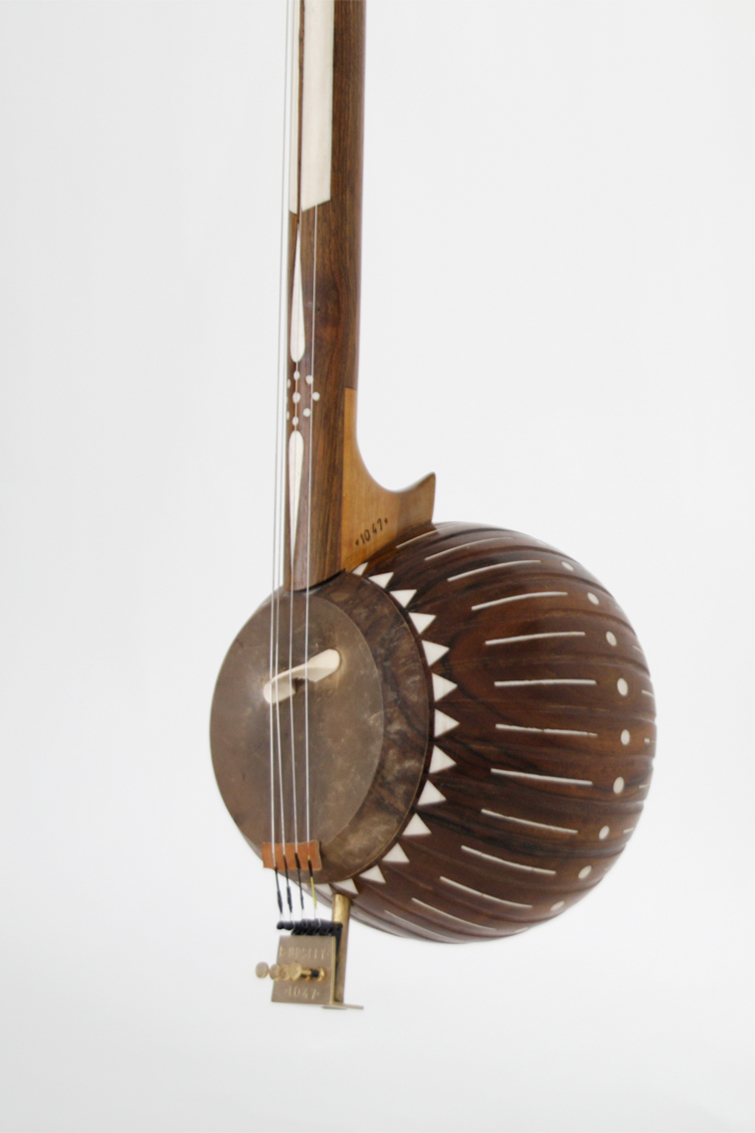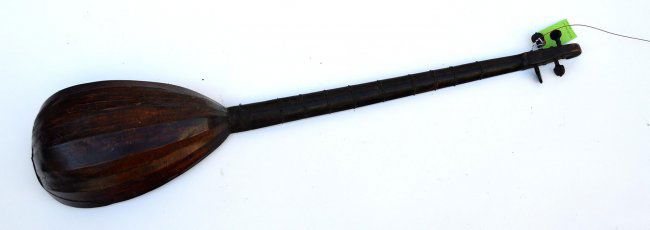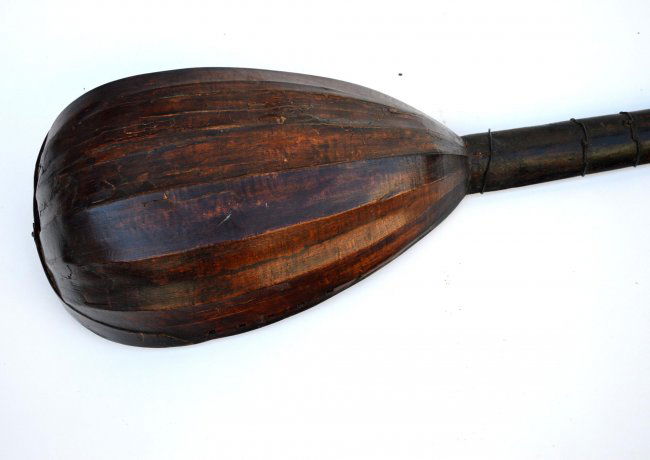
But during the Islamic era the musical box was enlarged, a fourth string was added, and the base for the tuning pegs (Bunjuk) or pegbox was added. In Pre-Islamic Arabia and Mesopotamia, the stringed instruments had only three strings, with a small musical box and a long neck without any tuning pegs.

And that the back (soundbox) be well rounded and its "thinning" (kharţ) towards the neck, as if it had been a round body drawn with a compass which was cut in two in order to extract two ‛ūds. Remains the vibrating body: twenty fingers. And the neck must be one third of the length and it is: ten fingers. Similarly for the depth, seven fingers and a half and this is the half of the width and the quarter of the length. This is why the width must be fifteen fingers as it is the half of this length. Remains the length of the strings: thirty fingers and on these strings take place the division and the partition, because it is the sounding length. And the measurement of the width of the bridge with the remainder behind: six fingers. length will be: thirty-six joint fingers-with good thick fingers-and the total will amount to three ashbār. The first known complete description of the ‛ūd and its construction is found in the epistle Risāla fī-l-Luḥūn wa-n-Nagham by 9th-century philosopher of the Arabs Yaʻqūb ibn Isḥāq al-Kindī. 1040) in his compendium on music Ḥāwī al-Funūn wa Salwat al-Maḥzūn. Īn early description of the "modern" oud was given by 11th-century musician, singer and author Al-Hasan Ibn al-Haytham (c. The oldest surviving oud is thought to be in Brussels, at the Museum of Musical Instruments. It is the direct successor of the Persian Barbat lute. The oud, as a fundamental difference with the western lute, has no frets and a smaller neck.

Similar instruments have been used in the Middle East, North Africa (particularly the Maghreb, Egypt and Somalia), and Central Asia for thousands of years, including Mesopotamia, Egypt, the Caucasus, the Levant, anatolian Greeks, Albania and Bulgaria there may even be prehistoric antecedents of the lute. The oud is very similar to other types of lute, and to Western lutes. The oud ( Arabic: عود, romanized: ʿūd, pronounced Somali: kaban or cuud) is a short-neck lute-type, pear-shaped, fretless stringed instrument (a chordophone in the Hornbostel–Sachs classification of instruments), usually with 11 strings grouped in six courses, but some models have five or seven courses, with 10 or 13 strings respectively. The Zurna – is a horn used in Turkish folk music, which looks like a wooden trumpet.(Composite chordophone sounded with a plectrum) The Mizmar – is another wind instrument of the oboe family and is used in a lot of belly dance music, especially in saidi style music. The Zumara (also, zummara or zummar) – is a reed instrument, a type of double clarinet. The Kawala (also known as shalabeya) – is a flute made from reeds similar to a nay. The Oud (or ud) – is a lute, with a pear-shaped body The Saz – belongs to the lute family and it has strings, a long neck and a round body. Throughout the Middle East and Africa, as well as northern India, Central Asia and Southeast Asia, the word rabab refers to a spike fiddle, one that has a small round or cylindrical body and a narrow neck. The rebaba’s body can be either square or pear-shaped and it has two or three strings played with a bow and stopped by the player’s fingers (like a violin). The rababa is used all over the Middle East, in Morocco and in various parts of Asia. The Rababa (also rebaba) – can have different shapes according to the area where it is played. The kanun is made of wood, fish skin, nylon chords that are plucked by the musician and metal keys to tune the chords (5 keys in the Arabic qanun and up to 8 in the Turkish version). The Kanoun (also kanun or qanun) – is a string instrument, which resembles the harp in terms of sound.

Sagat can also be spelt zagat, while zils can be spelt zills. The Sagat (Arabic) or Zils (Turkish) – are the finger cymbals, which are sometimes played by belly dancers whilst performing. The Tar (also called def) – is a large frame drum, like a large tambourine.
#Middle eastern stringed instruments skin#
The Riqq (also spelt riq or rik) – is a small tambourine, traditionally covered with goat or fish skin and equipped with brass cymbals around the edge. The dumbek is also called darbuka in Turkey and tablah in Egypt.Ī famous Egyptian tablah player who currently lives in the UK and who tours around the world to teach and perform is Hossam Ramzy.

The Dumbek (also spelt dumbec, doumbek, doumbec or dumbak) – this is the goblet shaped drum, which gives its distinctive rhythms to Middle Eastern and bellydance music.


 0 kommentar(er)
0 kommentar(er)
